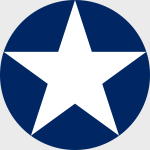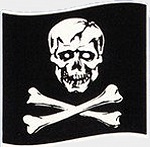Hobby Master HA8221 US Navy Chance-Vought F4U-1 Corsair Fighter - 17-F-13, VF-17 "Jolly Rogers", USS Bunker Hill CV-17), 1943 (1:48 Scale)
"Why should we have a navy at all? There are no enemies for it to fight except apparently the Army Air Force."
- General Carl Spaatz, Commander of the US 8th Army Air Force, after WWII
 Its gull-wing shape made it instantly recognizable. Its characteristic sound while in an attack dive led the Japanese to call it "The Whistling Death." Combined with its high speed, agility and toughness, the Vought F4U Corsair was one of the finest fighters ever built. Originally thought to be too powerful to fly from a carrier, the Corsair weaved a path of destruction in battle after battle during WWII, totally outclassing the much-feared Zero. The last of the great piston-engine fighters, the Corsair went on to become an important component of the US naval air power during the Korean War. Even while it was being replaced by jet aircraft, pilots flying this tough warbird were credited with downing a few MiG-15 jet fighters.
Its gull-wing shape made it instantly recognizable. Its characteristic sound while in an attack dive led the Japanese to call it "The Whistling Death." Combined with its high speed, agility and toughness, the Vought F4U Corsair was one of the finest fighters ever built. Originally thought to be too powerful to fly from a carrier, the Corsair weaved a path of destruction in battle after battle during WWII, totally outclassing the much-feared Zero. The last of the great piston-engine fighters, the Corsair went on to become an important component of the US naval air power during the Korean War. Even while it was being replaced by jet aircraft, pilots flying this tough warbird were credited with downing a few MiG-15 jet fighters.
In part because of its advances in technology and a top speed greater than existing Navy aircraft, numerous technical problems had to be solved before the Corsair entered service. Carrier suitability was a major development issue, prompting changes to the main landing gear, tail wheel, and tail hook. Early F4U-1s had difficulty recovering from developed spins, since the inverted gull wing's shape interfered with elevator authority. It was also found where the Corsair's left wing could stall and drop rapidly and without warning during slow carrier landings. In addition, if the throttle were suddenly advanced (for example, during an aborted landing) the left wing could stall and drop so quickly that the fighter could flip over with the rapid increase in power. These potentially lethal characteristics were later solved through the addition of a small, 6 in (150 mm)-long stall strip to the leading edge of the outer right wing, just outboard of the gun ports. This allowed the right wing to stall at the same time as the left.
Other problems were encountered during early carrier trials. The combination of an aft cockpit and the Corsair's long nose made landings hazardous for newly trained pilots. During landing approaches, it was found that oil from the opened hydraulically-powered cowl flaps could spatter onto the windscreen, severely reducing visibility, and the undercarriage oleo struts had bad rebound characteristics on landing, allowing the aircraft to bounce down the carrier deck. The first problem was solved by locking the top cowl flaps in front of the windscreen down permanently, then replacing them with a fixed panel. The undercarriage bounce took more time to solve, but eventually a "bleed valve" incorporated in the legs allowed the hydraulic pressure to be released gradually as the aircraft landed. The Corsair was not considered fit for carrier use until the wing stall problems and the deck bounce could be solved.
Pictured here is a 1:48 scale replica of a US Navy Chance-Vought F4U-1 Corsair fighter that served with VF-17 "Jolly Rogers", then embarked upon the USS Bunker Hill CV-17), during early 1943.
Sold Out!
Dimensions:
Wingspan: 10-inches
Length: 8-1/4-inches
Release Date: March 2022
 Historical Account: "Zekes" - In the Battle of the Solomon Sea, Ira Kepford pressed through blistering AAA fire from the Bunker Hill to down four enemy aircraft and damage a fifth, for which he was awarded the Navy Cross. On January 29th, Kepford led his wingman in an attack on 12 Japanese fighters over Rabaul; he scored four kills, and was awarded a Gold Star, for this action.
Historical Account: "Zekes" - In the Battle of the Solomon Sea, Ira Kepford pressed through blistering AAA fire from the Bunker Hill to down four enemy aircraft and damage a fifth, for which he was awarded the Navy Cross. On January 29th, Kepford led his wingman in an attack on 12 Japanese fighters over Rabaul; he scored four kills, and was awarded a Gold Star, for this action.
While returning to base on February 19th, 1944, Kepford spotted a low Japanese seaplane. Although he was alone (his wingman was forced to abort earlier, and Kepford was retained to cover bombers on-route to Rabaul), Kepford dived down and flamed the plane. He was then attacked by a flight of three Zekes, which dived onto him with a massive altitude advantage. Kepford took full advantage of the newly-installed water injection WEP to stretch out the chase, but the Zekes' energy advantage allowed them to slowly narrow the gap. As the lead Zeke opened fire, Kepford decided to "go for broke." He dropped his flaps and landing gear and nosed down until he was skimming the waves; as the Zeke roared over him, he pulled his Hog's nose up and opened fire. The Zeke's stabilizer crumpled under the snapshot, and the plane crashed into the waves. As Kepford pulled in his gear and flaps, the remaining two Zekes bracketed him . . . he was facing 2-to-1 odds, low and slow, and he was heading back in the direction of Rabaul. Kepford ran his throttle as far open as possible, and after gaining some speed he cut across the path of the port Zeke. The Japanese plane dropped to wave top level, opened fire, and sharply turned to fall onto his six . . . at which point the Zeke's left wing caught a wave top, and the plane cartwheeled across the ocean surface, disintegrated, and sank. The third Zeke was left behind as Kepford dashed for home, landing on fumes in his fuel tank.


